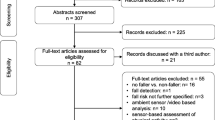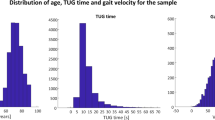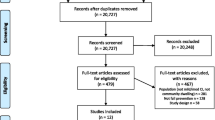Abstract
Older adults with cognitive impairment (CI) are twice as likely to fall compared to the general older adult population. Traditional fall risk assessments may not be suitable for older adults with CI due to their reliance on attention and recall. Hence, there is an interest in using objective technology-based fall risk assessment tools to assess falls within this population. This systematic review aims to evaluate the features and performance of technology-based fall risk assessment tools for older adults with CI. A systematic search was conducted across several databases such as PubMed and IEEE Xplore, resulting in the inclusion of 22 studies. Most studies focused on participants with dementia. The technologies included sensors, mobile applications, motion capture, and virtual reality. Fall risk assessments were conducted in the community, laboratory, and institutional settings; with studies incorporating continuous monitoring of older adults in everyday environments. Studies used a combination of technology-based inputs of gait parameters, socio-demographic indicators, and clinical assessments. However, many missed the opportunity to include cognitive performance inputs as predictors to fall risk. The findings of this review support the use of technology-based fall risk assessment tools for older adults with CI. Further advancements incorporating cognitive measures and additional longitudinal studies are needed to improve the effectiveness and clinical applications of these assessment tools. Additional work is also required to compare the performance of existing methods for fall risk assessment, technology-based fall risk assessments, and the combination of these approaches.

Similar content being viewed by others
Data availability
Data utilised for this study is available at the Health Services and Systems Signature Research Programme of DUke-NUS Medical School. De-identified data can be made available upon reasonable request.
References
Salari N, Darvishi N, Ahmadipanah M, et al. Global prevalence of falls in the older adults: a comprehensive systematic review and meta-analysis. J Orthop Surg Res. 2022;17(1):334. https://doi.org/10.1186/s13018-022-03222-1.
Tsai Y-J, Yang P-Y, Yang Y-C, et al. Prevalence and risk factors of falls among community-dwelling older people: results from three consecutive waves of the national health interview survey in Taiwan. BMC Geriatr. 2020;20(1):529. https://doi.org/10.1186/s12877-020-01922-z.
Vaishya R, Vaish A. Falls in older adults are serious. Indian J Orthop. 2020;54(1):69–74. https://doi.org/10.1007/s43465-019-00037-x.
Soomar SM, Dhalla Z. Injuries and outcomes resulting due to falls in elderly patients presenting to the Emergency Department of a tertiary care hospital – a cohort study. BMC Emerg Med. 2023;23(1):14. https://doi.org/10.1186/s12873-023-00784-z.
Montero-Odasso M, van der Velde N, Martin FC, et al. World guidelines for falls prevention and management for older adults: a global initiative. Age Ageing. 2022; 51(9):afac205. https://doi.org/10.1093/ageing/afac205.
Muir SW, Gopaul K, Montero Odasso MM. The role of cognitive impairment in fall risk among older adults: a systematic review and meta-analysis. Age and Ageing. 2012;41(3):299–308. https://doi.org/10.1093/ageing/afs012.
Kirova AM, Bays RB, Lagalwar S. Working memory and executive function decline across normal aging, mild cognitive impairment, and Alzheimer’s disease. Biomed Res Int. 2015;2015:748212. https://doi.org/10.1155/2015/748212.
Zhang W, Low LF, Schwenk M, et al. Review of gait, cognition, and fall risks with implications for fall prevention in older adults with dementia. Dement Geriatr Cogn Disord. 2019;48(1–2):17–29. https://doi.org/10.1159/000504340.
Radavelli-Bagatini S, Macpherson H, Scott D, et al. Impaired muscle function, including its decline, is related to greater long-term late-life dementia risk in older women. J Cachexia Sarcopenia Muscle. 2023;14(3):1508–19. https://doi.org/10.1002/jcsm.13227.
Kim M, Won CW. Sarcopenia is associated with cognitive impairment mainly due to slow gait speed: results from the Korean frailty and aging cohort study (KFACS). Int J Environ Res Public Health. 2019;16(9):1491. https://doi.org/10.3390/ijerph16091491.
Billot M, Calvani R, Urtamo A, et al. Preserving mobility in older adults with physical frailty and sarcopenia: opportunities, challenges, and recommendations for physical activity interventions. Clin Interv Aging. 2020;15:1675–90. https://doi.org/10.2147/cia.S253535.
Ng TKS, Han MFY, Loh PY, et al. Differential associations between simple physical performance tests with global and specific cognitive functions in cognitively normal and mild cognitive impairment: a cross-sectional cohort study of Asian community-dwelling older adults. BMC Geriatr. 2022;22(1):798. https://doi.org/10.1186/s12877-022-03434-4.
Chantanachai T, Taylor ME, Lord SR, et al. Risk factors for falls in community-dwelling older people with mild cognitive impairment: a prospective one-year study. PeerJ. 2022;10:e13484. https://doi.org/10.7717/peerj.13484.
Winter H, Watt K, Peel NM. Falls prevention interventions for community-dwelling older persons with cognitive impairment: a systematic review. Int Psychogeriatr. 2013;25(2):215–27. https://doi.org/10.1017/S1041610212001573.
Casas-Herrero A, Anton-Rodrigo I, Zambom-Ferraresi F, et al. Effect of a multicomponent exercise programme (VIVIFRAIL) on functional capacity in frail community elders with cognitive decline: study protocol for a randomized multicentre control trial. Trials. 2019;20(1):362. https://doi.org/10.1186/s13063-019-3426-0.
Eckstrom E, Parker EM, Lambert GH, et al. Implementing STEADI in Academic Primary Care to Address Older Adult Fall Risk. Innov Aging. 2017;1(2):igx028. https://doi.org/10.1093/geroni/igx028.
Phelan EA, Mahoney JE, Voit JC, et al. Assessment and management of fall risk in primary care settings. Med Clin North Am. 2015;99(2):281–93. https://doi.org/10.1016/j.mcna.2014.11.004.
Welch SA, Ward RE, Beauchamp MK, et al. The short physical performance battery (SPPB): a quick and useful tool for fall risk stratification among older primary care patients. J Am Med Dir Assoc. 2021;22(8):1646–51. https://doi.org/10.1016/j.jamda.2020.09.038.
Shimada H, Suzukawa M, Ishizaki T, et al. Relationship between subjective fall risk assessment and falls and fall-related fractures in frail elderly people. BMC Geriatr. 2011;11(1):40. https://doi.org/10.1186/1471-2318-11-40.
Rajagopalan R, Litvan I, Jung TP. Fall prediction and prevention systems: recent trends, challenges, and future research directions. Sensors (Basel). 2017;17(11):2509. https://doi.org/10.3390/s17112509.
Sun R, Sosnoff JJ. Novel sensing technology in fall risk assessment in older adults: a systematic review. BMC Geriatr. 2018;18(1):14. https://doi.org/10.1186/s12877-018-0706-6.
Marschollek M, Rehwald A, Wolf K-H, et al. Sensors vs. experts - a performance comparison of sensor-based fall risk assessment vs. conventional assessment in a sample of geriatric patients. BMC Med Inform Decision Making. 2011;11(1):48. https://doi.org/10.1186/1472-6947-11-48.
Ejupi A, Lord SR, Delbaere K. New methods for fall risk prediction. Curr Opin Clin Nutr Metab Care. 2014;17(5):407–11. https://doi.org/10.1097/mco.0000000000000081.
Chen M, Wang H, Yu L, et al. A systematic review of wearable sensor-based technologies for fall risk assessment in older adults. Sensors (Basel). 2022;22(18):6752. https://doi.org/10.3390/s22186752.
Bezold J, Krell-Roesch J, Eckert T, et al. Sensor-based fall risk assessment in older adults with or without cognitive impairment: a systematic review. Eur Rev Aging Phys Act. 2021;18(1):15. https://doi.org/10.1186/s11556-021-00266-w.
Ouzzani M, Hammady H, Fedorowicz Z, et al. Rayyan—a web and mobile app for systematic reviews. Syst Rev. 2016;5(1):210. https://doi.org/10.1186/s13643-016-0384-4.
Zou KH, O’Malley AJ, Mauri L. Receiver-operating characteristic analysis for evaluating diagnostic tests and predictive models. Circulation. 2007;115(5):654–7. https://doi.org/10.1161/CIRCULATIONAHA.105.594929.
Li F, He H. Assessing the accuracy of diagnostic tests. Shanghai Arch Psychiatry. 2018;30(3):207–12. https://doi.org/10.11919/j.issn.1002-0829.218052.
Nahm FS. Receiver operating characteristic curve: overview and practical use for clinicians. Korean J Anesthesiol. 2022;75(1):25–36. https://doi.org/10.4097/kja.21209.
Wells G, Shea B, O’Connell D, Peterson J, Welch V, Losos M, Tugwell P. The Newcastle-Ottawa Scale (NOS) for assessing the quality of nonrandomised studies in meta-analyses. 2013. http://www.ohri.ca/programs/clinical_epidemiology/oxford.asp.
Herzog R, Álvarez-Pasquin MJ, Díaz C, et al. Are healthcare workers’ intentions to vaccinate related to their knowledge, beliefs and attitudes? a systematic review. BMC Public Health. 2013;13(1):154. https://doi.org/10.1186/1471-2458-13-154.
Srulijes K, Klenk J, Schwenk M, et al. Fall risk in relation to individual physical activity exposure in patients with different neurodegenerative diseases: a pilot study. Cerebellum. 2019;18(3):340–8. https://doi.org/10.1007/s12311-018-1002-x.
Schniepp R, Huppert A, Decker J, et al. Multimodal mobility assessment predicts fall frequency and severity in cerebellar ataxia. Cerebellum. 2023;22(1):85–95. https://doi.org/10.1007/s12311-021-01365-1.
Adeli V, Korhani N, Sabo A, et al. Ambient monitoring of gait and machine learning models for dynamic and short-term falls risk assessment in people with dementia. IEEE J Biomed Health Inform. 2023;27(7):3599–609. https://doi.org/10.1109/JBHI.2023.3267039.
Najafi B, Aminian K, Loew F, et al. Measurement of stand-sit and sit-stand transitions using a miniature gyroscope and its application in fall risk evaluation in the elderly. IEEE Trans Biomed Eng. 2002;49(8):843–51. https://doi.org/10.1109/tbme.2002.800763.
Schniepp R, Huppert A, Decker J, et al. Fall prediction in neurological gait disorders: differential contributions from clinical assessment, gait analysis, and daily-life mobility monitoring. J Neurol. 2021;268(9):3421–34. https://doi.org/10.1007/s00415-021-10504-x.
Ng KD, Mehdizadeh S, Iaboni A, et al. Measuring gait variables using computer vision to assess mobility and fall risk in older adults with dementia. IEEE J Transl Eng Health Med. 2020;8:1–9. https://doi.org/10.1109/JTEHM.2020.2998326.
Fiems CL, Miller SA, Buchanan N, et al. Does a sway-based mobile application predict future falls in people with Parkinson disease? Arch Phys Med Rehabil. 2020;101(3):472–8. https://doi.org/10.1016/j.apmr.2019.09.013.
Gago MF, Yelshyna D, Bicho E, et al. Compensatory postural adjustments in an oculus virtual reality environment and the risk of falling in Alzheimer’s disease. Dement Geriatr Cogn Dis Extra. 2016;6(2):252–67. https://doi.org/10.1159/000447124.
Bilney B, Morris M, Webster K. Concurrent related validity of the GAITRite® walkway system for quantification of the spatial and temporal parameters of gait. Gait Posture. 2003;17(1):68–74. https://doi.org/10.1016/S0966-6362(02)00053-X.
Houdijk H, Appelman FM, Van Velzen JM, et al. Validity of DynaPort GaitMonitor for assessment of spatiotemporal parameters in amputee gait. J Rehabil Res Dev. 2008;45(9):1335–42. https://doi.org/10.1682/JRRD.2007.12.0209.
Schwesig R, Kauert R, Wust S, et al. Reliabilitätsstudie zum Ganganalysesystem RehaWatch / Reliability of the novel gait analysis system. RehaWatch. 2010;55(2):109–15. https://doi.org/10.1515/bmt.2010.025.
Greene BR, Redmond SJ, Caulfield B. Fall risk assessment through automatic combination of clinical fall risk factors and body-worn sensor data. IEEE J Biomed Health Inform. 2017;21(3):725–31. https://doi.org/10.1109/JBHI.2016.2539098.
Del Din S, Galna B, Godfrey A, et al. Analysis of free-living gait in older adults with and without Parkinson’s disease and with and without a history of falls: identifying generic and disease-specific characteristics. J Gerontol A Biol Sci Med Sci. 2019;74(4):500–6. https://doi.org/10.1093/gerona/glx254.
Greene BR, Premoli I, McManus K, et al. Predicting fall counts using wearable sensors: a novel digital biomarker for Parkinson’s disease. Sensors (Basel). 2021;22(1):54. https://doi.org/10.3390/s22010054.
Hauer K, Dutzi I, Gordt K, et al. Specific motor and cognitive performances predict falls during ward-based geriatric rehabilitation in patients with dementia. Sensors (Basel). 2020;20(18):585. https://doi.org/10.3390/s20185385.
Schwenk M, Hauer K, Zieschang T, et al. Sensor-derived physical activity parameters can predict future falls in people with dementia. Gerontology. 2014;60(6):483–92. https://doi.org/10.1159/000363136.
Lord S, Galna B, Verghese J, et al. Independent domains of gait in older adults and associated motor and nonmotor attributes: validation of a factor analysis approach. J Gerontol: Series A. 2012;68(7):820–7. https://doi.org/10.1093/gerona/gls255.
Sterke CS, van Beeck EF, Looman CW, et al. An electronic walkway can predict short-term fall risk in nursing home residents with dementia. Gait Posture. 2012;36(1):95–101. https://doi.org/10.1016/j.gaitpost.2012.01.012.
van Schooten KS, Pijnappels M, Rispens SM, et al. Ambulatory fall-risk assessment: amount and quality of daily-life gait predict falls in older adults. J Gerontol A Biol Sci Med Sci. 2015;70(5):608–15. https://doi.org/10.1093/gerona/glu225.
Gietzelt M, Feldwieser F, Gövercin M, et al. A prospective field study for sensor-based identification of fall risk in older people with dementia. Inform Health Soc Care. 2014;39(3–4):249–61. https://doi.org/10.3109/17538157.2014.931851.
Rehman RZU, Zhou Y, Del Din S, et al. Gait analysis with wearables can accurately classify fallers from non-fallers: a step toward better management of neurological disorders. Sensors. 2020;20(23):6992. https://doi.org/10.3390/s20236992.
Iluz T, Gazit E, Herman T, et al. Automated detection of missteps during community ambulation in patients with Parkinson’s disease: a new approach for quantifying fall risk in the community setting. J Neuroeng Rehabil. 2014;11:48. https://doi.org/10.1186/1743-0003-11-48.
Handelzalts S, Alexander NB, Mastruserio N, et al. Detection of real-world trips in at-fall risk community dwelling older adults using wearable sensors. Front Med (Lausanne). 2020;7:514. https://doi.org/10.3389/fmed.2020.00514.
Teno J, Kiel DP, Mor V. Multiple stumbles: a risk factor for falls in community-dwelling elderly. A prospective study. J Am Geriatr Soc. 1990;38(12):1321–5. https://doi.org/10.1111/j.1532-5415.1990.tb03455.x.
Marques NR, Camilo GF, Martini Lopes de Dos Santos AP, et al. The ability of gait kinematic parameters to predict falls in older adults with cognitive impairments living in long term institutions. Clin Biomech (Bristol, Avon). 2019;65:123–7. https://doi.org/10.1016/j.clinbiomech.2019.04.011.
Boyle PA, Yu L, Wilson RS, et al. Poor decision making is a consequence of cognitive decline among older persons without Alzheimer’s disease or mild cognitive impairment. PLoS ONE. 2012;7(8):e43647. https://doi.org/10.1371/journal.pone.0043647.
Kearns WD, Fozard JL, Becker M, et al. Path tortuosity in everyday movements of elderly persons increases fall prediction beyond knowledge of fall history, medication use, and standardized gait and balance assessments. J Am Med Dir Assoc. 2012;13(7):665.e7-665.e13. https://doi.org/10.1016/j.jamda.2012.06.010.
Kelsey JL, Procter-Gray E, Hannan MT, et al. Heterogeneity of falls among older adults: implications for public health prevention. Am J Public Health. 2012;102(11):2149–56. https://doi.org/10.2105/ajph.2012.300677.
Chantanachai T, Sturnieks DL, Lord SR, et al. Risk factors for falls in older people with cognitive impairment living in the community: systematic review and meta-analysis. Ageing Res Rev. 2021;71:101452. https://doi.org/10.1016/j.arr.2021.101452.
Beauchet O, Annweiler C, Montero-Odasso M, et al. Gait control: a specific subdomain of executive function? J Neuroeng Rehabil. 2012;9:12. https://doi.org/10.1186/1743-0003-9-12.
Mirelman A, Herman T, Brozgol M, et al. Executive function and falls in older adults: new findings from a five-year prospective study link fall risk to cognition. PLoS ONE. 2012;7(6):e40297. https://doi.org/10.1371/journal.pone.0040297.
Mistridis P, Krumm S, Monsch AU, et al. The 12 years preceding mild cognitive impairment due to Alzheimer’s disease: the temporal emergence of cognitive decline. J Alzheimers Dis. 2015;48(4):1095–107. https://doi.org/10.3233/jad-150137.
Zhou Y, R. Zia Ur Rehman, C. Hansen, et al. Classification of neurological patients to identify fallers based on spatial-temporal gait characteristics measured by a wearable device. Sensors (Basel). 2020;20(15):4098. https://doi.org/10.3390/s20154098.
Piau A, Wild K, Mattek N, et al. Current state of digital biomarker technologies for real-life, home-based monitoring of cognitive function for mild cognitive impairment to mild Alzheimer disease and implications for clinical care: systematic review. J Med Internet Res. 2019;21(8):e12785. https://doi.org/10.2196/12785.
Bergmann JHM, McGregor AH. Body-worn sensor design: what do patients and clinicians want? Ann Biomed Eng. 2011;39(9):2299–312. https://doi.org/10.1007/s10439-011-0339-9.
Chen JH, Lauderdale DS. Cognitive function, consent for participation, and compliance with wearable device protocols in older adults. J Gerontol A Biol Sci Med Sci. 2019;74(2):269–73. https://doi.org/10.1093/gerona/gly032.
Low STH, Sakhardande PG, Lai YF, et al. Attitudes and perceptions toward healthcare technology adoption among older adults in Singapore: a qualitative study. Front Public Health. 2021;9:588590. https://doi.org/10.3389/fpubh.2021.588590.
Paleyes A, Urma R-G, Lawrence ND. Challenges in deploying machine learning: a survey of case studies. ACM Comput Surv. 2022;55(6):114. https://doi.org/10.1145/3533378.
Sarker IH. Machine learning: algorithms, real-world applications and research directions. SN Computer Science. 2021;2(3):160. https://doi.org/10.1007/s42979-021-00592-x.
Tarekegn A, Ricceri F, Costa G, et al. Predictive modeling for frailty conditions in elderly people: machine learning approaches. JMIR Med Inform. 2020;8(6):e16678. https://doi.org/10.2196/16678.
Acknowledgements
The research was conducted at the Future Health Technologies at the Singapore-ETH Centre, which was established collaboratively between ETH Zurich and the National Research Foundation Singapore. This research is supported by the National Research Foundation, Singapore under its Campus for Research Excellence and Technological Enterprise (CREATE) programme. The authors would also like express gratitude to the Centre for Ageing Research & Education (CARE) at Duke-NUS Medical School. Data collected for the study can be made available upon reasonable request and permission from CARE at Duke-NUS Medical School.
Author information
Authors and Affiliations
Contributions
Conceptualisation: V.J.W Koh; systematic search: V.J.W Koh, W.X. Lai; data synthesis: V.J.W Koh, W.X. Lai, K.Z. Tan; writing—original draft preparation: V.J.W Koh; writing—review and editing: V.J.W Koh, W.X. Lai, K.Z. Tan, N. Singh, D.B Matchar, A.W.M Chan; supervision, resources and funding acquisition: D.B Matchar, A.W.M Chan; All authors have read and reviewed the manuscript.
Corresponding author
Ethics declarations
Competing interests
The authors declare no competing interests.
Additional information
Publisher's Note
Springer Nature remains neutral with regard to jurisdictional claims in published maps and institutional affiliations.
Appendix
Appendix
Table 6
About this article
Cite this article
Koh, V., Xuan, L.W., Zhe, T.K. et al. Performance of digital technologies in assessing fall risks among older adults with cognitive impairment: a systematic review. GeroScience 46, 2951–2975 (2024). https://doi.org/10.1007/s11357-024-01098-z
Received:
Accepted:
Published:
Issue Date:
DOI: https://doi.org/10.1007/s11357-024-01098-z




